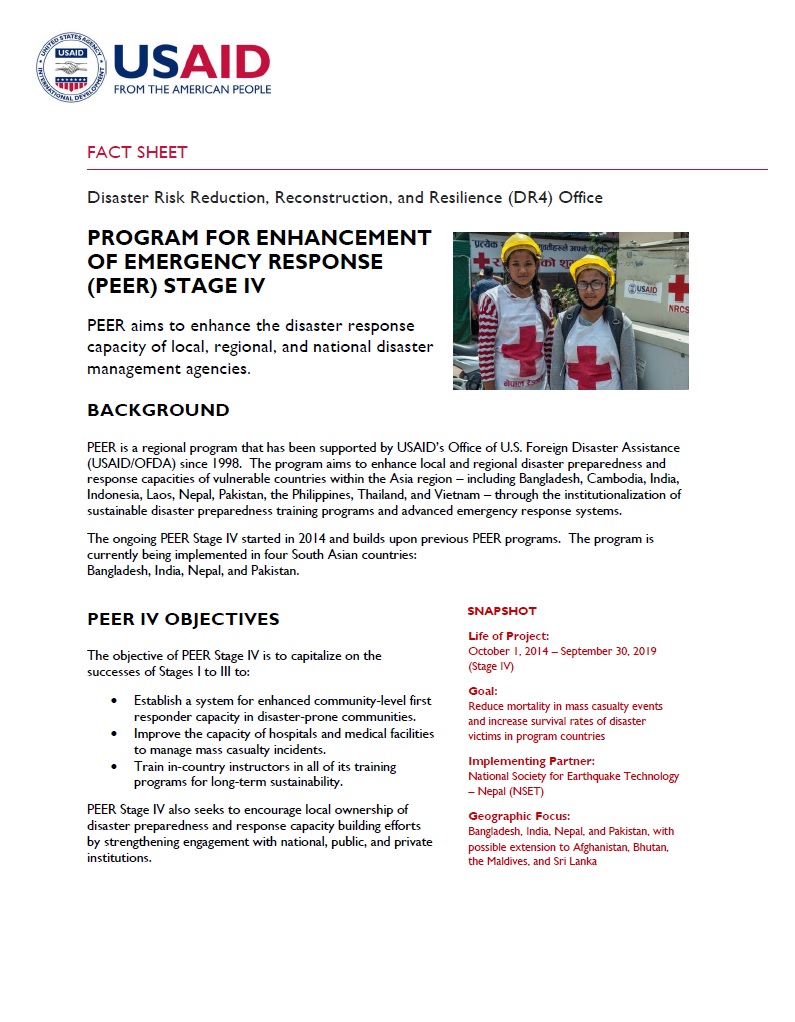Disaster Risk Reduction, Reconstruction, and Resilience (DR4) Office
PROGRAM FOR ENHANCEMENT OF EMERGENCY RESPONSE (PEER) Stage iV
PEER aims to enhance the disaster response capacity of local, regional, and national disaster management agencies.
Background
PEER is a regional program that has been supported by USAID’s Office of U.S. Foreign Disaster Assistance (USAID/OFDA) since 1998. The program aims to enhance local and regional disaster preparedness and response capacities of vulnerable countries within the Asia region – including Bangladesh, Cambodia, India, Indonesia, Laos, Nepal, Pakistan, the Philippines, Thailand, and Vietnam – through the institutionalization of sustainable disaster preparedness training programs and advanced emergency response systems.
The ongoing PEER Stage IV started in 2014 and builds upon previous PEER programs. The program is currently being implemented in four South Asian countries: Bangladesh, India, Nepal, and Pakistan.
PEER IV Objectives
The objective of PEER Stage IV is to capitalize on the successes of Stages I to III to:
- Establish a system for enhanced community-level first responder capacity in disaster-prone communities.
- Improve the capacity of hospitals and medical facilities to manage mass casualty incidents.
- Train in-country instructors in all of its training programs for long-term sustainability.
PEER Stage IV also seeks to encourage local ownership of disaster preparedness and response capacity building efforts by strengthening engagement with national, public, and private institutions.
PROJECT ACTIVITIES
- Community Action for Disaster Response (CADRE): The CADRE training course teaches individuals to be better prepared to respond to disasters in their communities. The three-day modular course incorporates simple elements of medical first response and collapsed structure search-and-rescue operations.
- Medical First Responders (MFR): The MFR course provides individuals with the first response knowledge and skills necessary to assess, treat, and transport sick or injured patients following an emergency or disaster. The course is delivered over a 13-day period.
- Collapsed Structure Search and Rescue (CSSR): The CSSR course prepares emergency first-responders to search for, stabilize, and extricate victims trapped by collapsed structures.
- Hospital Preparedness for Emergencies (HOPE): HOPE is a training course for hospital staff and medical and non-medical health care personnel to prepare health care facilities that can respond effectively to emergencies involving large patient load.
- Swift Water Rescue (SWR): SWR is a newly introduced course being developed under PEER Stage IV in water rescue or training on swift water rescue.
- Instructor Development Trainings: PEER has a standard system for developing instructors. The program supports development of curricula for different training stages to form a pool of local instructors.
PEER’s effectiveness was demonstrated during the response to the April 25, 2015 earthquake and its aftershocks in Nepal. PEER graduates were mobilized by their respective organizations and played key roles in the response operations. PEER-trained personnel serving in the Nepal Army, the Nepal Police, and the Nepal Armed Police Force Search and Rescue (SAR) teams, jointly saved more than 1,675 lives. MFR graduates served in field hospitals in the affected districts, and HOPE-trained personnel at the Tribhuvan University Teaching Hospital implemented the hospital’s disaster preparedness plan, enabling the facility to effectively cope with the increased workload following the earthquakes. In addition, more than 670 CADRE national volunteers were mobilized for response operations in affected communities.








Comment
Make a general inquiry or suggest an improvement.